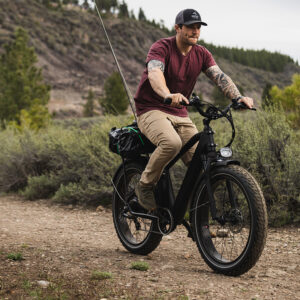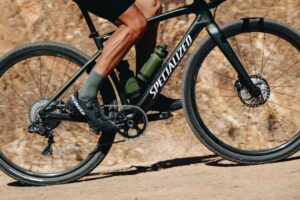Electric bikes (e-bikes) have exploded in popularity over the past few years, giving riders new ways to commute, explore, and exercise. One of the biggest choices you’ll face when shopping is fat tire vs regular e-bikes. At first glance, they might just look like different styles of bicycles, but the differences go much deeper — from performance and handling to price and long-term comfort.
In this guide, we’ll break down the pros and cons of both fat tire and regular e-bikes, help you decide which is right for your needs, and give you a side-by-side comparison table for quick reference.
What Is a Fat Tire E-Bike?
A fat tire e-bike comes with oversized tires, usually 3.8” to 5” wide. Originally designed for snow and sand riding, fat tire bikes have grown popular for their stability and ability to handle diverse terrain. The large tires act like natural suspension, smoothing out bumps and giving riders more confidence on loose or uneven surfaces.
Common fat tire e-bikes include:
What Is a Regular E-Bike?
A regular e-bike (sometimes called a standard or commuter e-bike) uses tires closer to traditional bicycles — usually 1.75” to 2.5” wide. These bikes prioritize efficiency, speed, and road handling. They feel more like a traditional bicycle, just with the boost of a motor.
Common regular e-bikes include:
Fat Tire vs Regular E-Bikes: Key Differences
Here’s a quick side-by-side comparison:
| Feature | Fat Tire E-Bike | Regular E-Bike |
|---|---|---|
| Tire Width | 3.8”–5.0” | 1.75”–2.5” |
| Best Terrain | Snow, sand, gravel, trails | Pavement, bike paths, light gravel |
| Comfort | High (natural cushion) | Medium (depends on suspension) |
| Speed | Lower (heavier, more rolling resistance) | Higher (lighter, more efficient) |
| Range | Shorter (battery drains faster) | Longer (more efficient) |
| Weight | 65–80 lbs on average | 45–60 lbs on average |
| Maneuverability | Stable but slower to turn | Agile and responsive |
| Cost | $1,200–$2,500 | $1,000–$4,000+ |
| Best For | Off-road, adventure riders | Commuters, fitness riders |
Pros of Fat Tire E-Bikes
- All-terrain capability: Ride sand, snow, gravel, or trails.
- Comfortable: The wide tires soak up bumps and vibrations.
- Stable ride: The extra grip gives beginners confidence.
- Fun factor: Fat tire e-bikes feel adventurous and rugged.
Cons of Fat Tire E-Bikes
- Heavier: Extra weight makes transport and storage harder.
- Shorter range: Bigger tires create rolling resistance.
- Slower: They can feel sluggish compared to regular e-bikes.
- Bulkier size: Not ideal for small apartments or tight spaces.
Pros of Regular E-Bikes
- Efficient: Go faster and further with less battery drain.
- Lightweight: Easier to carry up stairs or load on a rack.
- Versatile for commuting: Great on pavement, bike lanes, and paths.
- More style variety: Road, hybrid, gravel, and commuter options.
Cons of Regular E-Bikes
- Less stable off-road: Narrower tires don’t grip loose surfaces as well.
- Less natural cushioning: Comfort depends on suspension.
- Limited terrain: Not designed for sand or snow.
Which One Is Right for You?
- Choose a fat tire e-bike if: You want a versatile, rugged bike that can handle all conditions, and you value comfort and stability over speed. Great for riders who live near sand, snow, or gravel.
- Choose a regular e-bike if: You want a fast, efficient commuter or fitness bike, with longer range and lighter weight. Ideal for riders who stick mostly to pavement or well-maintained paths.
Our Recommendation
For most urban and suburban riders, a regular e-bike is the smarter choice — it’s lighter, faster, and more efficient for daily use. But if you want to explore trails, ride year-round in snow, or just love the confidence of big tires, a fat tire e-bike can be an absolute blast.
If you’re still unsure, think about your primary riding surface:
- 90% pavement → regular e-bike
- 50%+ trails/sand/snow → fat tire e-bike
Final Thoughts
Both fat tire and regular e-bikes open up exciting possibilities for commuting, fitness, and adventure. With models starting around $1,000 and scaling up from there, it’s worth test riding both styles if you can.
Whether you go fat or stick with regular, you’ll still enjoy the freedom and fun that only an e-bike can provide.
Related Links:
- Best Fat Tire E-Bikes Guide
- Best Commuter E-Bikes Guide
- Ride1Up Review
- Best Gravel Bikes Guide
- Best E-Bikes Guide
Why Trust This Guide?
Jeffrey South is the founder of Best Bike Brands. With over 30 years in the cycling world as a shop owner, mechanic, and industry insider, he now shares reviews, guides, and insights to help riders choose the best bikes and gear with confidence.




